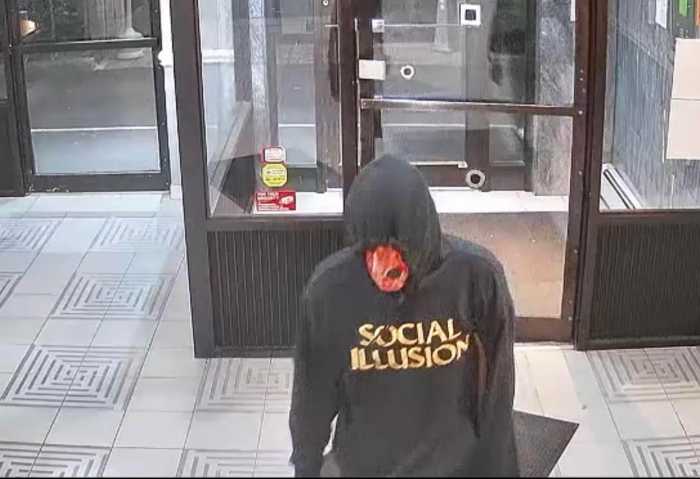
BY JEFFERSON SIEGEL | A small parcel of land on Stanton St. that has stood vacant for more than 30 years has the potential to become a battleground between garden activists and developers. As gentrification continues apace on the Lower East Side, last Sunday a group of neighbors and activists decided to push back.
Recently, locals were alarmed to find a sign reading, “Lot For Sale, Residential Development” on the “L”-shaped plot facing Stanton and Attorney Sts. In a presentation to Community Board 3 earlier this year, plans were unveiled for a five-story building with 14 apartments on the 5,000-square-foot lot.
Though residents in an adjoining building had been making surreptitious forays into the lot for years through a ground-floor window, the construction of a building that would practically abut the walls and windows of 141 Attorney St. and 179 Stanton St. spurred neighbors and local activists to action.
Last Sunday morning, Claire Costello, whose window overlooks the lot, approached the chain-link fence on Stanton St. Waiting for her outside the gate were five people from the group “Made In LES.”
“I tippled the gate,” she said in her Irish-accented voice, pointing to a narrow entryway under the fence that was now ajar at a 45-degree angle, providing just enough room for the garden-minded activists to squeeze under. A half-dozen volunteers from the Times Up! Gardening Committee followed them into the lot.
In addition to worries about a new building blocking light and air, there was the fear of losing the chance to create a new community garden for the neighborhood.
“I’ve spoken to all three schools on the street, P.S. 140, P.S. 142 and the Manhattan Charter School. They were interested in a ‘learn to grow’ program,” in a garden, she explained. Costello also envisions a community garden providing space for artists to exhibit work.
During several hours, volunteers piled rotted lumber against a wall and filled a pile of garbage bags with pieces of concrete slabs. Dodie Shepard, 9, lifted a shovel bigger than she was as her sister, Scarlett, 6, planted flowers.
“We had an idea, let’s do a simple cleanup to gauge the interest of the community,” said John Donahue, a graphic designer and 25-year resident of the block, as he stacked debris against one wall of the lot.
“Various groups and community people are interested in open space. Today was kick-started by the proposed development,” Donohue explained. “It is in the interest of the community to have green space. Our garden will add some lungs to the asphalt of the city playground.”
The parcel consists of three lots; two and a half lots are owned by the city while the other half lot is owned by William Gottlieb’s estate. The Gottlieb family controls a sizable real estate portfolio in the West Village and East Village.
Sunday’s action, which was planned in a month, garnered support from several groups. Green NYC delivered tools and a wheelbarrow for the cleanup. A page on the web site 596acres.org lit up with conversations from interested parties.
Wendy Brawer, founding director of the global Green Map System, was a driving force in last Sunday’s activity.
“Many of us have been dreaming of this space for years,” she said while watching soil emerge from under the rubble and weeds. “Today’s cleanup is the staring point of a community space.
“Stanton Street is on fire,” she continued, pointing out all the new buildings and businesses on the block. “The neighborhood is becoming a convergence point of all kinds of social innovators who want to create green jobs in a healthier community.”
“More of this needs to happen,” said Susan Howard, another longtime L.E.S. resident, as she watched hardy perennials and leadwort being planted alongside an existing apple tree.
“Unlike Bloomberg’s vision of green space, which is pavement and planters, this is a place where people can get their hands into the dirt and grow things to eat, to bring light and air to this urban environment and reduce the heat-island effect,” Howard added.
Across the street from the lot is the century-old Stanton Street Shul, where an early planning meeting for the cleanup took place.
“We are very happy that neighbors on this block are taking responsibility for cleaning up two derelict lots which attracted garbage on the streets. How could you be against that?” said shul member Esther Malke. “Having a green space will make this block into what shul members and neighbors need.”
During the past month, Costello posted fliers throughout the neighborhood announcing Sunday’s action. Petitions left in bars and restaurants garnered dozens of signatures. During Sunday’s cleanup, 250 more passersby signed petitions calling for the garden’s creation.
Costello plans to submit the petitions to C.B. 3 and to GreenThumb, which provides support to community gardens throughout the city.
Another cleanup is planned in a month. Over the next six months, Costello hopes to remove the last of the gravel and find organizations willing to donate plants and soil. She also envisions a fundraiser in the lot featuring local artists.
The creation of the first community garden in 1974, the Bowery Houston Community Farm and Garden, founded by Liz Christy, sparked a rush to claim and convert weed-ravaged vacant lots into pocket parks throughout the East Village and Lower East Side.
With less than a dozen community gardens now in the Lower East Side, the data-sharing collective 596acres.org lists only four vacant lots with the potential to become gardens.
“It’s now or never,” warned Brawer. “If we don’t take action now, the potential for community space is lost forever.”
For a video of the garden action, see https://youtu.be/xabPrQrB4d4
For information on how to help, e-mail Claire.Stanton.Info@gmail.com



































